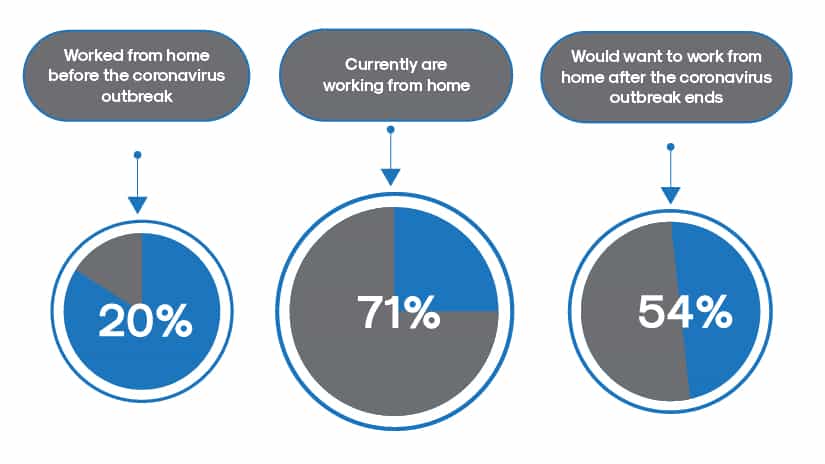The COVID19 pandemic has had a significant impact on the way we manage our workforce and deliver quality outputs for business. Unfortunately, the impact will continue to remain the same for a few more years. With this mindset, employers are prioritizing hybrid workforce solutions over traditional work strategies.
Before we dig deep into – what a hybrid workplace model is and how to develop the right one for your organization, let us put the limelight into past work statistics and the future work scenario based on the recent market status.
Market Overview
Based on the Pew Research Center survey, only 20% of employees across all industries worked from home before the pandemic. Henceforth, adapting the work-from-home strategy in 2020 was indeed a challenging task for almost all employers and employees. However, this has become an integral part nowadays.
71% of employees are still working from home in this year. While 54% of employees prefer to use the same work strategy even after the pandemic ends.
For instance, a recent graduate who has just got a job will appreciate work from home over in-office work as they have spent their initial years at home. In comparison, a professional adult working for years in an office environment will love to return back to the campus. Hence, the thoughts vary from person to person.

Fig1: Percentage of employed adults who were working from home, are currently working from home, and want to work from home even after the pandemic ends. (Source: Pew Research Center)
Table of contents to follow
- What is a hybrid work model?
- Benefits of hybrid workforce solutions.
- An insight into hybrid workforce solutions
- How to develop the right hybrid workforce model for your organization?
- Take your business to the next step with a hybrid workforce.
Concentrating on these points will give you a complete guide into hybrid work.
What is a hybrid work model?
Hybrid work is the newest addition to the business vocabulary representing a working model comprising both work from home and work from office strategy. It adds flexibility to the employees, allowing them to choose between in-office and remote work.
With the pandemic outbreak, companies had adopted the remote work format to have a continuous workflow. Now, when things are going back to normal, organizations are imposing the hybrid work model for employee wellbeing and active business performance. No doubt, choosing hybrid workforce solutions is definitely the best strategic decision you can ever think of.
Benefits of hybrid workforce solutions
Employers are leveraging hybrid workforce strategy just to offer top-notch work experience to the employees. Here we have listed down the perks in the following section.
-
Employee satisfaction with added flexibility: As we said, not every employee agrees to work from the office till today. With the continuous remote work environment, employees prefer to have either of them or both at some point in time. Hence, the need for the right hybrid workplace model.
Guess what? The flexibility criteria offered with your hybrid work strategy satisfies the employees to a wide extent. Employees who return to the office after two long years may prefer to work from home maybe once a week. Similarly, employees constantly working from home may want to return to the office two or three days a week. The hybrid model thus satisfies every employee, meeting their requirements and maintaining job sustainability.
-
Hybrid workforce costs low: Hybrid workforce solutions save dollars for employers. We all know how deliberately remote work solutions save money for organizations as well as for the employees. As per FlexJob’s survey, 38% estimate that employees can save $5000 a year after working remotely. While according to Small Biz Genius, employers can actually save an average of $11000 per year by applying for this work-from-home strategy. The figures are enough to disclose how the hybrid workforce can lower down the cost consumption as the hybrid strategy itself has a remote work module to prefer.
-
Improve work productivity: A hybrid work model can offer flexibility in the workplace. Simultaneously, it can also generate high productivity by boosting individual efficiency and dealing with their work experience. Encouraging this work culture in your organization, employees feel great to focus more on their daily tasks. This bridges the gap between the employees and the employers, adding a good balance of collaboration and creativity. Employees with top-notch work experience feel excited to deliver better outputs, hence an improvement in work productivity.
An insight into hybrid workforce solutions
The above-mentioned benefits represent why remote work is evolving into hybrid work. Probably, the following statistics will make this work culture more prominent.
Based on the Pulse of the American Worker survey,
- 87% of people desire to work from home at least one day a week.
- 68% of American workers believe this to be the best work model.
Based on the Remote Work & Compensation Pulse survey,
- 8% of remote employees are willing to work from the full-time office post-pandemic.
- 48% of remote employees want to make this remote work culture permanent.
- 44% want to have both.
The news update on The New Indian Express has highlighted that 70% of organizations are opting for this hybrid workplace model even if they have workforce management software. Both employees and employers are excited to accept this work culture.
So, what are your plans for the following year? Are you heading towards developing a hybrid workforce model?
If so, then you are at the place. Keep reading this write-up. You can actually gain better insights into the hybrid workforce.
How to develop the right hybrid workforce model for your organization?
Isn’t the hybrid work statistics enough to encourage you for this workforce model? Here we have listed down the development process for a better work environment.
-
Plan out to create the best model: The first step to opt for a hybrid work model is to plan out the requirements and priorities. A couple of things you should understand while creating the best model. For example, you may require hybrid workforce technology to run a constructive and successful work culture. You should know which workforce management software can be teamed up with your strategy.
Similarly, you should develop separate guidelines and work policies to balance both the work environment. Definitely, the operational challenges are bound to occur. With proper work guidelines, you can overcome these issues without any hassle.
-
Collaborate with all your team members: Hybrid workplace represents both in-office and remote employees. For a better work environment, collaborating with all the team members is very necessary. Adopt a fruitful hybrid work technology to avail the benefits of hybrid workforce. This smoothens the work process, enabling the remote workers to connect with the team, no matter where they are working from.
Irrespective of the workstation, the hybrid work strategy has the capability to deliver quality outputs for the business.
-
Establish a relationship between in-office and remote workers: When you are planning to develop a strong team in your organization, the primary thing to consider is establishing a relationship between your in-office and remote workers. It doesn’t matter where they are. They should use proper tools and technologies to remain connected with their co-workers.
Hybrid work environments need trust from every individual employee. Once you gain trust, building a bond and gathering more opportunities becomes easier.
-
Ensure offering equal opportunities: While you are imposing remote and office work culture in your organization, you should ensure offering equal opportunities to all your employees. Instead of prioritizing proximity bias, make sure you have the same flexibility for all your staff. No matter how great the employee is in producing hard work, he or she should not be cornered for any reason. Offering the same opportunities to the remote and in-office workers is always the best decision while setting up a strong hybrid workforce model.
-
Don’t miss out on asking for feedback: Transitioning the remote work scenario into hybrid work culture is a great evolution. Though this has turned out to be a buzzword in the marketplace, you should ensure no flaws arrive while developing the work model. To turn the process successful, you can simply ask for feedback from the team members and learn about the flaws for further optimization. Get team reviews constantly and build a manage your workforce effectively.
Take your business to the next step with a hybrid workforce
Do you agree that the future of work lies in hybrid workforce solutions? As a consequence, companies are implementing successful strategies to stay ahead of the crowd and build robust employee engagement.




